Something went wrong!
Hang in there while we get back on track
Best attractions in Padua

The Basilica of Saint Anthony in Padua is one of Northern Italy's most significant spiritual and architectural landmarks. Blending Romanesque, Gothic, and Byzantine elements, this extraordinary church captivates with its impressive facade and minaret-like bell towers.

The Scrovegni Chapel in Padua is a must-see for art and history lovers. Located in the heart of Padua, in Piazza Eremitani, this masterpiece is famous for its Giotto frescoes, painted between 1303 and 1305. These stunning murals, depicting scenes from the Old and New Testaments, are considered a groundbreaking moment in art history. Highlights such as the Last Judgment and the Cielo Stellato make the chapel truly exceptional.

At the Prato della Valle, you’ll find the largest square in Padua - an impressive ensemble featuring an artificial island surrounded by a water canal and adorned with 78 historical statues.

In the historic center of Padua, you will find the Palazzo del Bo, which has been the main seat of one of the oldest universities in Europe since 1493. This impressive Renaissance building, named after an earlier tavern, houses the Teatro Anatomico, the oldest anatomical theater in the world.

The Piazza dei Signori in the historic center of Padua is one of the city's most important squares, shaping public life since the 14th century. This rectangular square is lined with medieval and Renaissance buildings featuring characteristic arcades, dominated by the striking Torre dell'Orologio.

In the oldest botanical garden in the world, the Orto botanico di Padova, you stroll through nearly 500 years of scientific history. Founded in 1545 as a medicinal plant garden and designated a UNESCO World Heritage site since 1997, the park is home to over 6,000 plant species, including the famous Palma di Goethe from 1585.

In the heart of Padua stands the majestic Palazzo della Ragione, whose history dates back to the 12th century and which once served as a courthouse and marketplace. This impressive building houses the "Salone" - one of the largest medieval halls in Europe, measuring an astonishing 80 by 27 meters and nearly 40 meters high.

In the heart of Padua, you will find the Caffè Pedrocchi, one of the most historic coffee houses in Italy, opened in 1831 by Francesco Pedrocchi and famously open day and night until 1916.

The impressive Basilica di Santa Giustina is one of the largest sacred buildings in the world and majestically stands at Prato della Valle, the most significant square in Padua. This massive church, whose origins date back to before the year 1000, blends early Christian, Romanesque, Gothic, Renaissance, and Baroque elements into a stunning work of art.

In the restored cloisters of the former Eremitani Monastery, you will find the Musei Civici, a fascinating museum complex that brings together art and history from antiquity to the 19th century. The centerpiece is the Museum of Medieval and Modern Art, featuring around 3,000 paintings by renowned masters like Giorgione, Titian, and Tintoretto.

On the Piazza della Frutta, one of the most important squares in the historic center of Padua, the city's trade has been thriving since the 10th century. The impressive Palazzo della Ragione and the medieval Colonna del Peronio with its intricate fruit representations shape the square's appearance.
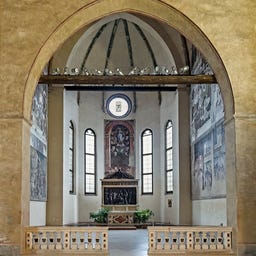
In the Church of the Eremitani in Padua, you will find a moving testament to the Padovan Renaissance from the 15th century with the Cappella Ovetari. This chapel, founded by Antonio Ovetari, once housed one of the most significant fresco cycles by the young Andrea Mantegna, who immortalized the stories of Saints James and Christopher here between 1450 and 1460 using groundbreaking perspective techniques.

The Duomo di Padova, the main cathedral of the city, has a rich history that dates back to the early 4th century. After several predecessor buildings, the current cathedral was consecrated in 1754 after two hundred years of construction and impresses with its magnificent dome, octagonal lantern, and three harmonious naves.
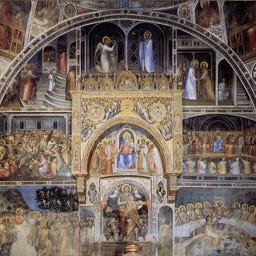
Right next to the Duomo of Padua, you will find the Battistero, an architectural gem from the 12th century that is one of the most significant baptismal chapels in Italy. The walls and the impressive dome are adorned with one of the most important fresco cycles of the 14th century, created by Giusto de Menabuoi between 1375 and 1376. In the dome, you can admire the stunning "Paradiso" depiction with Christ at the center, while the walls showcase scenes from the lives of John the Baptist, Mary, and Jesus.
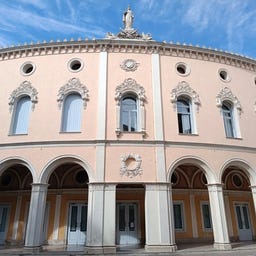
In the historic center of Padua, you'll find the Teatro Verdi, a classic Italian theater from the 18th century that has been a cultural landmark of the city since its opening in 1751. The elegant horseshoe-shaped auditorium, with three tiers and a gallery, accommodates 752 visitors and is crowned by an impressive ceiling painting of the "Danza delle Ore."

In the Palazzo del Bo at the University of Padua, you will find the oldest permanently installed anatomical theater in the world, dating back to 1594. This elliptical wooden structure, with its six intricately carved tiers made of walnut, has remained unchanged since its construction and was used for the training of medical students through dissections until 1872. Above the entrance, the inscription "Mors ubi gaudet succurrere vitae" (Where death rejoices in helping life) serves as a reminder of the theater's original purpose, where even music was played during lessons to lighten the atmosphere.

On the Piazza delle Erbe, one of the most important squares in the historic center of Padua, urban life has been thriving for over 1000 years. As you stroll through the bustling fruit and vegetable market in the morning, you are surrounded by the impressive backdrop of the mighty Palazzo della Ragione from the early 13th century. This historic square, which has served as a marketplace, a place of execution, and a venue for historical horse races over the years, transforms in the afternoon into a popular meeting spot for aperitifs. The medieval houses with their various styles of arcades, which still characterize the square today, are particularly distinctive.
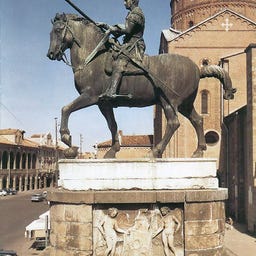
Before you stands the first major equestrian statue since antiquity: the bronze monument of the Venetian commander Erasmo da Narni, known as Gattamelata, created by Donatello between 1446 and 1453.
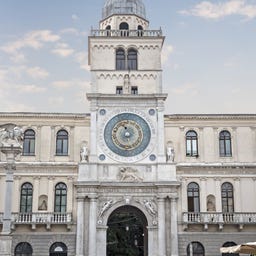
The Torre dell'Orologio in Padua's Piazza dei Signori is an impressive testament to medieval engineering: here ticks the oldest astronomical clock in the world, with a diameter of 5.6 meters. The 30-meter-high tower, originally built in the 14th century as the east gate of the Carrarese Palace, took on its current form through extensive renovations in 1426 and the installation of the astronomical clock in 1437.
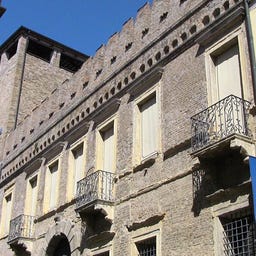
In the historic center of Padua, you will find the Palazzo Zabarella, an impressive building from the 12th to early 13th century, built on Roman foundations. Originally a medieval palace that served as a private residence until the early 20th century, it gained its current neoclassical appearance through extensive renovations in the 1920s. In the 19th century, the interior was adorned with works by notable artists such as Giuseppe Borsato, Giovanni Carlo Bevilacqua, and Francesco Hayez. After an elaborate ten-year restoration, the palace has housed the Fondazione Bano since 1996, which regularly organizes international art exhibitions here.

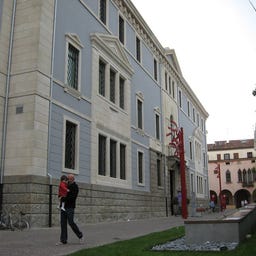
In the heart of Padua, the Centro culturale Altinate/San Gaetano awaits you as a fascinating testament to Venetian architectural history. Designed by Vincenzo Scamozzi, this building was constructed as a monastery between 1582 and 1693, later served as a courthouse, and now shines as a modern cultural center after extensive renovations.
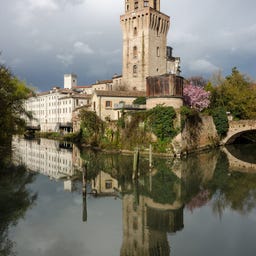
In the impressive Specola di Padova, a former defense tower from the 9th century, you will find one of the most significant astronomical museums in Italy. The 50-meter-high tower was transformed into a state-of-the-art observatory in the 18th century and housed the first public lightning rod of the Republic of Venice in 1773.

The Villa Molin near Padua is one of the most significant Venetian villas from the late 16th century, designed by Vincenzo Scamozzi for the Molin family in 1597. The elegant structure impresses with its square layout, an imposing portico with Ionic columns, and a light-filled central hall featuring large thermal windows.
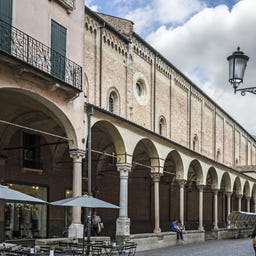
The Chiesa di Santa Maria dei Servi is an impressive Gothic church from the 14th century, built on the ruins of the palace of Nicolò da Carrara.
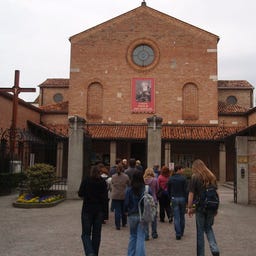
In the heart of Padua, you will find the Santuario di San Leopoldo Mandić, a significant pilgrimage site with a rich history. Originally founded in the 16th century by Capuchin monks, the building was destroyed during World War II and was rebuilt in 1950 according to the plans of architect Giovanni Morassutti.

In the historic Ospedale di San Francesco Grande, once the most important hospital in Padua, you can discover the fascinating MUSME today - a modern medical museum that opened its doors in 2015. Here, centuries-old medical traditions blend with interactive exhibits: from the anatomical theater stage with a talking body model to the virtual dissection table, the museum makes the evolution of healing arts tangible.
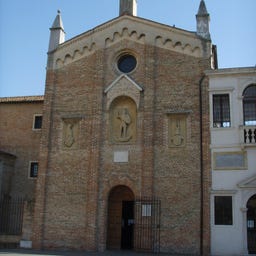
In the simple brick building of the Oratorio di San Giorgio, dating back to the 14th century, you will find one of the most significant fresco treasures of Padua, which has been part of the UNESCO World Heritage since 2021.

The impressive Porta Ognissanti from the 16th century is one of the best-preserved city gates of the historical fortifications of Padua. Built from white Istrian stone, the gate impresses with its four pairs of columns, intricate decorations, and the clock tower made of Nanto stone that was added in 1535.
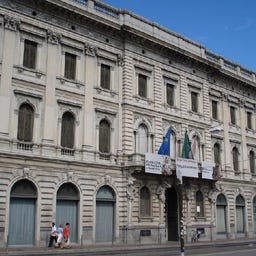
The Palazzo Zuckermann, completed in 1914, impresses with its elegant blend of Art Nouveau and neoclassical elements, featuring a stunning main staircase made of Carrara marble under a light-filled glass roof. In the building commissioned by Enrico Zuckermann, you will find two significant collections of the Municipal Museums of Padua: the Museum of Applied Arts with over 2,000 craft exhibits from the Middle Ages to the present, and the Bottacin Museum with its valuable coin collection.
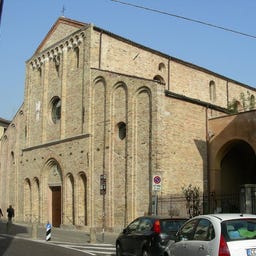
In the Church of Santa Sofia, you encounter one of the most important examples of Venetian-Romanesque architecture, with a history dating back to the 9th century. The sacred building, constructed on the remains of a temple dedicated to Apollo, was founded by Saint Prosdocimo and received its characteristic Romanesque-Gothic bell tower in the 13th century.
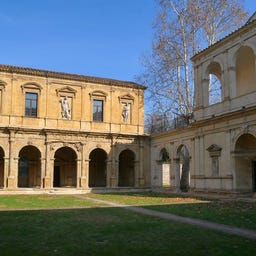
Near the Basilica di Sant'Antonio, you will find the Loggia e Odeo Cornaro, a fascinating example of Padua's High Renaissance from the 16th century. This expansive complex, built by Alvise Cornaro, combines a magnificent loggia for theatrical performances with an octagonal music hall, the Odeo, renowned for its exceptional acoustics.
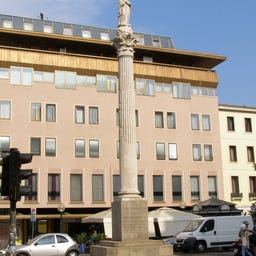
Piazza Garibaldi in the historic center of Padua has a rich history that dates back to pre-Roman times. Originally known as Piazza dei Noli, the square served as an important marketplace and transportation hub in the Middle Ages, where horses and carriages were rented out.
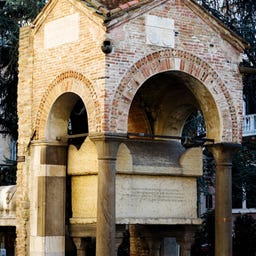
In the heart of Padua, on the Piazza Antenore, stands a medieval monument that, according to legend, houses the mortal remains of the mythical city founder Antenore. In 1274, during the construction of an orphanage, a burial site with human remains, a sword, and gold coins was discovered. The judge and poet Lovato Lovati quickly declared these to be the bones of Antenore.
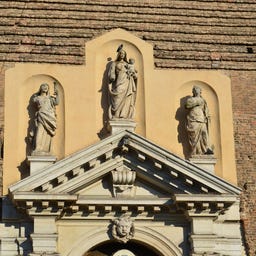
The Basilica del Carmine, known locally as "i Carmini," is one of the most significant churches in Padua and has a history spanning over 800 years. In this single-nave church, with its unfinished façade from the 18th century, you will find remarkable artistic treasures, including Renaissance frescoes and the revered image of the "Madonna di dietro Corte," which is said to have brought about miraculous events during the plague of 1576.
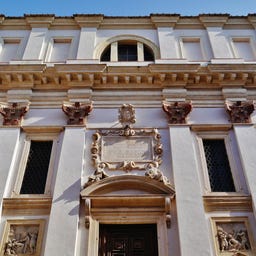
The Chiesa di San Gaetano combines Mannerist and Baroque architecture into an impressive sacred building from the 16th century. Designed by Vincenzo Scamozzi between 1578 and 1581, the church features a façade inspired by Roman triumphal arches and an octagonal layout. Inside, you can expect a rich art collection with works by notable artists like Pietro Damini and Alessandro Maganza, as well as an impressive ceiling fresco by Guy Louis II Vernansal depicting paradise. Today, the church is part of Italy's largest cultural center, the Centro culturale Altinate/San Gaetano.

The impressive city walls of Padua, the Mura di Padova, tell a nearly 2000-year story of defense from Roman times to the Venetian Renaissance. In their current form, they combine remnants from various eras, including communal fortifications from the 13th century under Ezzelino III da Romano and expansions by the Carraresi in the 14th century.
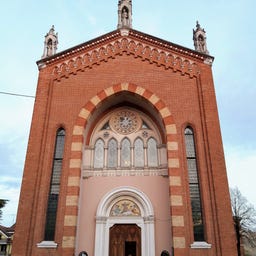
In the Santuario dell'Arcella, a Catholic church in the eponymous district of Padua, you can find the cell where Saint Anthony of Padua, the most famous student of Saint Francis of Assisi, passed away on June 13, 1231.

In the heart of Padua stands the Palazzo Comunale, an impressive complex that has served as the city administration's seat since the 13th century. Also known as the Palazzo Moroni, this complex combines various architectural styles from Romanesque to Baroque and includes significant buildings like the Palazzo della Ragione, the Torre degli Anziani, and the Palazzo del Podestà.
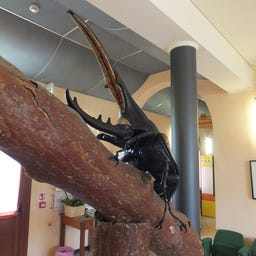
In the Italian city of Padua, you can visit Esapolis, the largest insect museum in the country, spanning 2,500 square meters and guarded by an impressive Hercules beetle model at the entrance. The museum, which opened in 2008, is housed in a historic building from the early 20th century that once served as the royal silkworm research station.
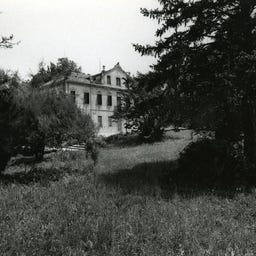
In the Villa Giusti, a former farmhouse from the 18th century in Mandria di Padova, Italy, the armistice agreement that ended World War I between Italy and Austria was signed on November 3, 1918.
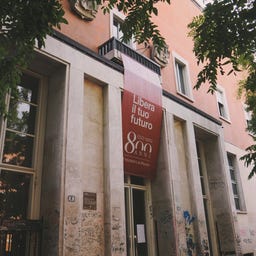
In the western part of the Piazza Capitaniato, you will find the Palazzo Liviano, a fascinating example of metaphysical architecture from the 20th century, designed by Gio Ponti for the University of Padua. The building incorporates remnants of the historic Palazzo del Capitanio and features impressive frescoes by Massimo Campigli, as well as a sculpture of its namesake, Tito Livio, in the atrium.
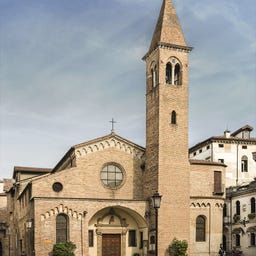
The Chiesa di San Nicolò is one of the oldest churches in Padua, combining Romanesque and Gothic architectural elements into an impressive whole. You'll immediately notice the Gothic decorations, the rose window, and the Lombard portal depicting Saint Nicholas on the complex exterior facade. Inside, you'll find an asymmetrical layout with a vaulted ceiling from the 14th century, Renaissance artworks, and a painting by Giandomenico Tiepolo from 1777. Originally a medieval church, it underwent several transformations over the centuries until a comprehensive restoration between 1966 and 1971 revealed many historical elements.
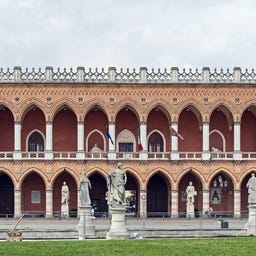
The elegant Loggia Amulea at Prato della Valle, the largest square in Padua, showcases its distinctive arcade front in a neo-Gothic style today. The building was constructed in 1860 based on an economic design by Eugenio Maestri, after an earlier ambitious plan by Giuseppe Jappelli from 1827 was abandoned.

The Chiesa di San Francesco Grande is an impressive Gothic church from the early 15th century, distinguished by its characteristic portico with 37 arches and terracotta decorations. In its bright, spacious interior, you will find late Gothic frescoes, a remarkable Stations of the Cross from the 18th century, and a valuable altarpiece by Paolo Pino.
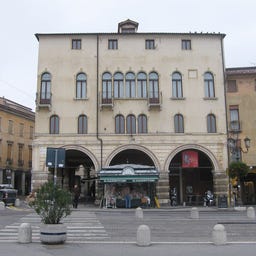
At the Museo del precinema in Padua, you can embark on a fascinating journey into the prehistory of film: here you'll find a unique collection of magic lanterns, optical toys, and shadow theaters. The collection is the work of Laura Minici Zotti, who performed worldwide as a lanternist from the 1970s to the 2010s.

The Loggia dei Carraresi is the only fully preserved part of the former Reggia Carrarese, the magnificent residence of the ruling Da Carrara family in Padua. Built between 1339 and 1343, the arcade features its characteristic pink marble columns from Verona and serves as a sheltered passageway between the palace sections, also providing an escape route in case of emergency.
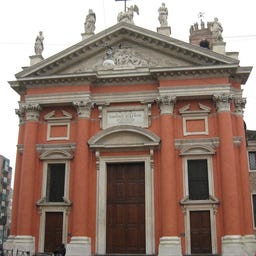
The Chiesa di Santa Maria del Torresino is one of the most significant examples of Venetian Baroque from the 18th century, built between 1718 and 1726 according to the plans of Gerolamo Frigimelica.
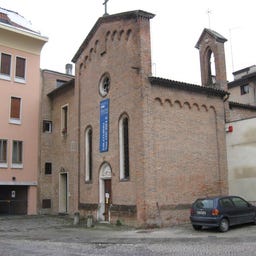
In the small Oratorio di San Michele, which has been a UNESCO World Heritage site since 2021, you will find one of the most significant fresco treasures of Padua from the 14th century. The sacred building, constructed in 1397, features a chapel completely painted by Jacopo da Verona, showcasing the life of Mary in impressive detail.
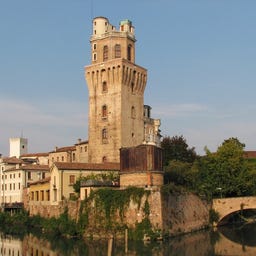
The impressive Castelvecchio in Padua has a rich history that dates back to the 9th century, originally known as Castello della Torlonga. In the 13th century, Ezzelino III da Romano expanded the complex and added the infamous prison cells, which were later referred to as "graves for the living."

The Italian Synagogue of Padua is the only active synagogue of the once-thriving Jewish community in Padua, built in 1584 in the historic ghetto. In this baroque prayer house, which measures 18 by 7 meters, the intricately designed Bimah with its octagonal roof and the Torah ark, made from wood of a tree struck by lightning from the university's botanical garden, are particularly impressive.
In the historic Bishop's Palace from the 15th century, right next to the Cathedral of Padua, you will discover an impressive collection of religious art from the 9th to the 19th century. The magnificent Hall of the Bishops captivates with its restored frescoes depicting the first hundred bishops of Padua, starting with San Prosdocimo.
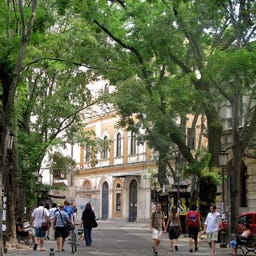
On the historic Piazza Capitaniato, which was established in the 14th century as the courtyard of the Carrarese Palace by Ubertino da Carrara, you can still feel the academic spirit of Padua today. The square is lined with significant university buildings, including the Palazzo Liviano from the 1930s and the Palazzo del Capitanio, which houses various municipal and university facilities.
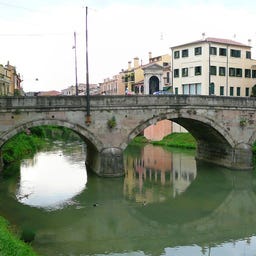
The Ponte Molino is one of the oldest still-used structures in Padua, with a history dating back to between 30 and 40 BC. This striking stone bridge spans the Tronco Maestro with five arches and was once part of the city's main road, the "Stra' Maggiore."
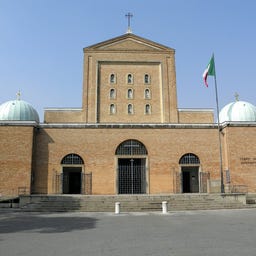
In the Terranegra district of Padua, the National Temple of the Unknown Inmate serves as a national memorial for the Italian victims of Nazi concentration camps. The construction, initiated by concentration camp survivor Don Giovanni Fortin, was consecrated in 1953 and houses not only a Catholic church but also the Museum of Internment, which documents the history of around 650,000 deported Italians.

On the Piazza del Santo, you will find one of the most significant squares in Padua, dominated by the impressive Basilica del Santo. Since the 13th century, this place, which is partially under Vatican administration, has been a center of devotion and urban life.
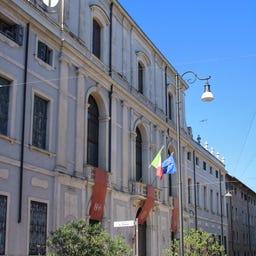
In the heart of Padua stands the Palazzo Maldura, an impressive example of Venetian noble architecture from the 16th century. Designed by Giovan Battista Novello, the palace took on its current form in 1769 at the request of lawyer Andrea Maldura, who wanted to showcase the social rise of his merchant family.
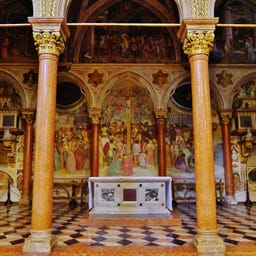
In the magnificent Basilica di Sant'Antonio in Padua, you will discover the Cappella di San Giacomo, an elegant chapel from the 14th century that captivates with its late Gothic architecture. Commissioned by Bonifacio Lupi in 1372, the chapel impresses with three ribbed vaults and five pointed arches supported by red columns with gilded capitals.
The Ponte Corvo is one of the four ancient arch bridges that still showcase the Roman heritage of Padua today. Built in the 1st or 2nd century AD, this structure spans the Bacchiglione River with three partially buried arches.
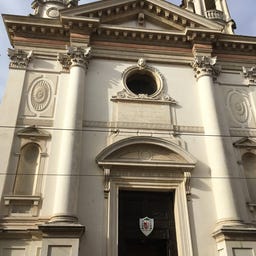
The Chiesa di Santa Croce is the only Rococo church in Padua, built between 1737 and 1749 according to the designs of Francesco Vecellio.
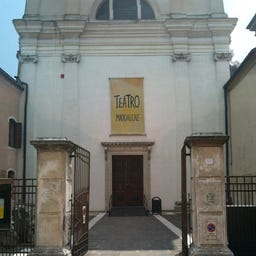
In a former oratory from the 14th century, you will find the intimate Teatro Maddalene, which, with only 99 seats, is one of the smallest theaters in Padua. The historic building was originally part of a convent of the Gerolimini Fathers and impresses with its classical facade featuring Ionic columns, as well as a single-nave interior with Corinthian columns.
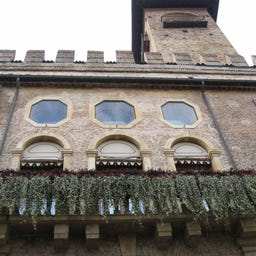
In the heart of Padua stands the impressive Palazzo Capodilista, one of the largest palaces in the city and a rare example of medieval residential architecture. Built in the early 13th century around an existing watchtower, the structure impresses with its 35-meter tall tower and distinctive battlements supported by six large "Paduan" arches.
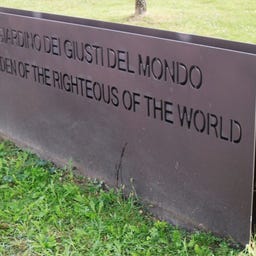
In this special garden by the San Gregorio Canal, brave individuals who stood against genocides like the Holocaust and the Rwandan genocide in the 20th century have been honored since 2008. The park, artistically designed by Elio Armano, combines rust-colored concrete steles and memorial plants into an impressive ensemble that echoes the famous quote by Hannah Arendt: "You can always say yes or no."
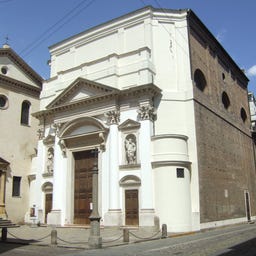
The Chiesa del Corpus Domini is one of the oldest churches in Padua and was first mentioned in documents in 964. After a tower collapse in the 17th century, it was rebuilt between 1711 and 1730 in its current style, featuring an impressive facade and monumental gable.
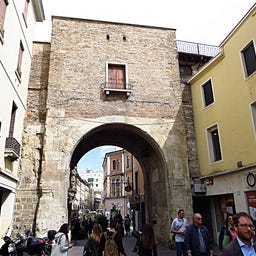
The Porta Altinate is one of the four royal gates of the historic city wall of Padua and today leads you as a pedestrian passage to the Piazza Garibaldi. This impressive stone gate from the 12th century was burned down by Crusaders in 1256 during the fight against Ezzelino III da Romano, but was rebuilt as early as 1286.
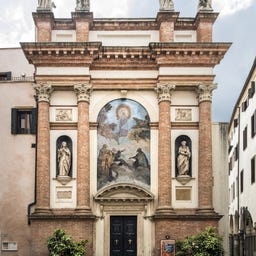
The Chiesa di San Canziano in the heart of Padua has a history that spans almost 1000 years, documented as far back as 1034. The current structure was built between 1595 and 1617 through a radical renovation of the medieval church and impresses with its striking façade featuring Corinthian columns and sculptures by Antonio Bonazza.
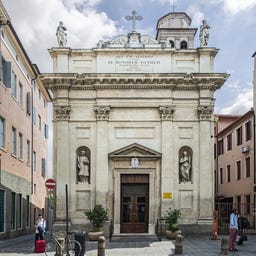
The Chiesa di San Daniele has a fascinating founding story: In 1076, when the relics of the city’s patron were being transported, they mysteriously stopped at this spot, prompting Bishop Olderico to vow to build a church here.
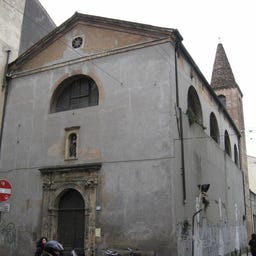
In the Chiesa di Sant'Agnese, you will find a fascinating example of the transformation of a historic church into a contemporary art space. This Romanesque-Gothic-Renaissance building from the 12th century, with its original bell tower from the 13th century, has a rich history—transitioning from a parish church to a garage for decades, and now to an art gallery.
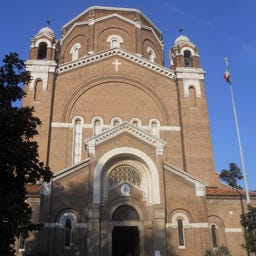
The Tempio della Pace near the train station in Padua uniquely combines a Catholic church and a war memorial. Built in a neo-Romanesque style, the temple was created as a result of a vow made by the citizens of Padua during World War I and was inaugurated in 1934.
In the heart of Padova's old town, you’ll discover the Ponte di San Lorenzo, one of the oldest flat-arched bridges in the world, built between 47 and 30 BC. This Roman bridge impresses with its slender pillars and three flat arches that span a length of 53 meters.
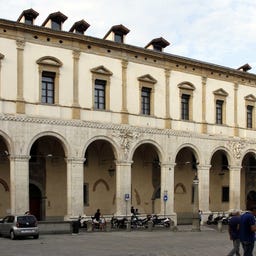
Between Piazza Duomo and Via Monte di Pietà stands the impressive Palazzo Monte di Pietà, whose history dates back to the 13th century. Originally owned by the moneylender Rinaldo Scrovegni, the building became the seat of the Monte di Pietà in the 16th century after a tumultuous history, serving as an institution to combat usury.

In the historic old town of Padua, you will find the Chiesa di San Luca Evangelista, a church with a rich history dating back to the 12th century. The current building, featuring its Ionic facade and distinctive statues of saints, was constructed in 1381 and houses remarkable art treasures, including frescoes by the famous Giusto de' Menabuoi from the 14th century.
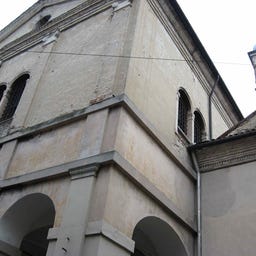
In the Chiesa di San Pietro Apostolo in Padua, you can embark on a fascinating journey through architectural history, from Romanesque elements to Baroque details. The church's origins date back to the 4th century when it was still a modest chapel, before being rebuilt in the 11th century and later used as a convent church by Benedictine nuns.
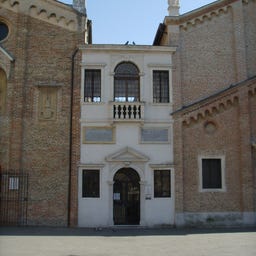
Located right next to the Basilica of Saint Anthony, the Scuola del Santo houses one of the most significant fresco treasures of Padua from the early 16th century. In this two-story building, which has been the seat of the Anthony Brotherhood since 1427, you will find an impressive cycle of fifteen frescoes, including the first independent works of the young Titian.
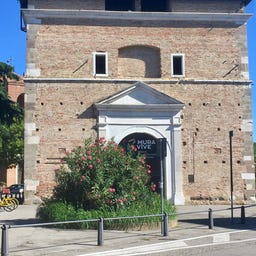
The Porta Liviana, also known as the Porta Ponte Corvo, is one of the most important historical city gates of Padua's 16th-century fortifications. This impressive structure was built after the city's siege in 1509 and was named in honor of Bartolomeo d'Alviano, the military strategist who designed Padua's defensive works.
In Via Sant'Eufemia, you discover a fascinating testament to the history of Padua, spanning from the 1st to the 21st century. On the remains of an early Christian church dedicated to Saint Eufemia, a magnificent palace was built starting in 1540 under Antonio Mocenigo and the famous architect Andrea Palladio.
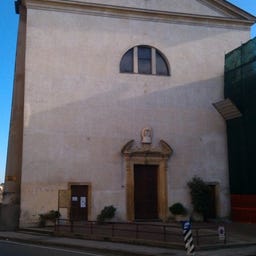
The Chiesa di Ognissanti in Padua has an impressive history that dates back to the 4th century when it was part of a hospital for travelers. The Romanesque bell tower and the three portals define the church's exterior, while inside, a mix of Romanesque and Mannerist elements awaits you.
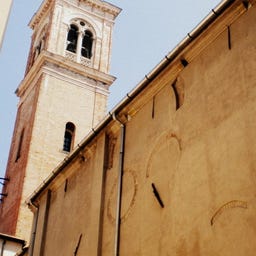
In the Church of Sant'Andrea, you will find a historic church from the 12th century that has changed its appearance several times over the centuries - most notably in 1614, when its orientation was altered and the facade was moved to the side.

The Porta San Giovanni is one of the eight historical city gates of Padua and was built between 1528 and 1530 by architect Giovanni Maria Falconetto for the Republic of Venice. This impressive structure made of trachyte and Istrian stone stands out with its square shape and two facades, each 14 meters wide, adorned with Corinthian half-columns and a triangular pediment.
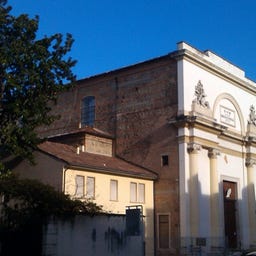
In the Chiesa della Beata Vergine Immacolata, also known as the Chiesa di Santa Maria Iconia, you can embark on a fascinating journey through time from the 12th to the 19th century. Originally built as a Templar church, this site once served as an important resting point for Crusaders on their way to Venice and the Holy Land.
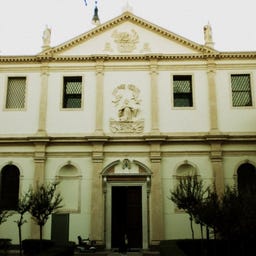
On the picturesque Bacchiglione, the Chiesa di San Benedetto Vecchio stands as an architectural journey through the centuries, from its Romanesque origins to Baroque elements. Founded in 1195 by Girolamo Forzatè, the church features a magnificent altar from the 17th century and significant artworks, including the impressive Transfiguration by Alessandro Maganza.
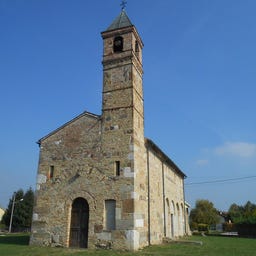
Just 5 kilometers from the historic center of Padua, you will find the Chiesa di San Michele, one of the oldest churches in the region dating back to the 6th-7th century. The originally simple cubic cell was expanded in the 12th century into a three-nave basilica with semi-circular apses and houses two remarkable fresco cycles from the 10th to 13th centuries.
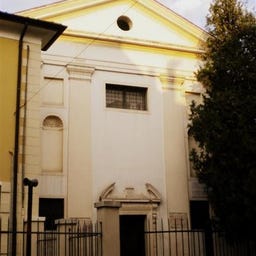
In the Chiesa di Santa Caterina, Romanesque and Baroque architecture blend into a harmonious whole that has shaped the cityscape of Padua since 1144. This is where the children of Galileo Galilei were baptized, and the small church houses the mortal remains of the famous composer Giuseppe Tartini.
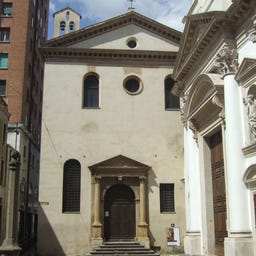
In the Scuola di San Rocco, a fascinating building that blends Gothic and Renaissance styles from the 16th century, you will find an impressive collection of religious frescoes. Constructed between 1525 and 1542 by the Brotherhood of San Rocco, the building features two main halls, with the lower hall adorned with works by Domenico Campagnola and Girolamo Tessari.

In Italy's oldest university library, you'll find an impressive collection of over 700,000 volumes, including more than 3,000 manuscripts and 1,500 incunabula. Founded in 1629 by the Republic of Venice, the library initially resided in the magnificent Sala dei Giganti before moving to its current building in 1912 as Italy's first purpose-built library.
In the terraced Giardini della Rotonda, you’ll find a green oasis on the edge of the old town of Padua, covering 5,163 m². This public park was created in the 1920s around one of the city’s first water reservoirs and impresses with its blend of Art Nouveau and Art Deco, featuring an impressive fountain as its centerpiece.
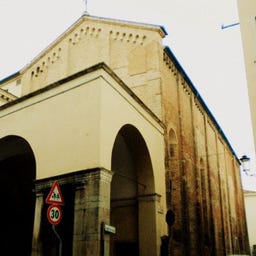
In the medieval Chiesa di Sant'Antonio in Vienna, you can expect an impressive blend of Gothic architecture and art historical treasures. Founded in the early 13th century by the Hospitallers of Saint Anthony, the church captivates with its single-nave design and an extraordinary vault construction inspired by French styles.

The Chiesa di San Prosdocimo combines elements of Renaissance and Mannerism, reflecting a rich architectural history from the 12th to the late 17th century. Consecrated in 1583 as part of a Benedictine monastery, the church has had a tumultuous history, transforming into a Napoleonic military camp and later reopening as a military church in 1990.
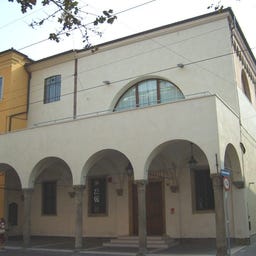
In the picturesque Riviera Tito Livio, you will find the Teatro Ruzante, a fascinating example of Padua's changing history. The theater, as it stands today, was originally the church of San Giorgio from the 12th century, which over time served as a Benedictine convent, a Napoleonic warehouse, and even the headquarters of the fascist federation.
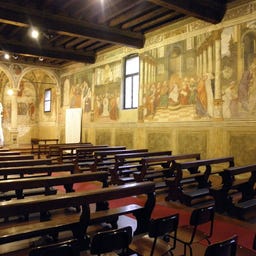
In the medieval Scuola del Carmine, right next to the Basilica del Carmine in Padua, you will find an impressive collection of 16th-century frescoes by artists like Giulio Campagnola, Domenico Campagnola, and Girolamo Tessari. The Gothic-Renaissance building was used by the Brotherhood of the Blessed Virgin of Carmel, who have been performing their prayers and charitable works here since 1367. The single-nave chapel captivates with its fully painted walls and a magnificent Rococo altar from 1739. Today, the Scuola is maintained by dedicated volunteers from the Touring Club Italiano and is open to visitors.
The Ponte Altinate is one of the historic Roman bridges in Padua, northern Italy, built in the 1st century BC over a branch of the Brenta River. Today, the road Riviera dei Ponti Romani runs over it, concealing the ancient bridge structure beneath. The sophisticated Roman engineering is evident in the precise proportions of the three arches, with the main arch having a height-to-span ratio of 1:4. Nearby, you can also visit the Ponte San Lorenzo, another Roman bridge that is open for viewing at certain times.
